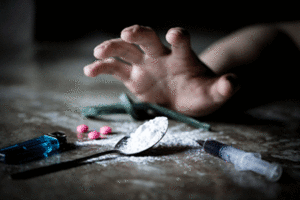Heroin has been and continues to be a major contributor to the opioid epidemic in the United States. Heroin was responsible for an estimated 15,500 overdose deaths in 2016, and heroin use and abuse only continue to escalate as restrictions are placed on prescription painkillers, making heroin both cheaper and easier to obtain as an alternative.
Heroin is also perhaps more dangerous now than it has ever been before. The main reason for this is that the way that drug manufacturers are keeping the cost of heroin down is by mixing it with fentanyl.
Fentanyl is an incredibly potent synthetic opioid that is both cheaper and easier to produce than heroin as well as more deadly. It takes only a fraction of fentanyl to trigger a potentially fatal overdose, and for people buying heroin, there is no way of knowing how much of it is actually fentanyl.
This only serves to highlight how vital it is to seek out addiction treatment as soon as possible to avoid an overdose and to stem the intense physical and mental damage that heroin abuse causes.
It is incredibly difficult to quit using heroin due to its intense, uncomfortable, and extremely difficult to manage withdrawal symptoms. Withdrawal symptoms from heroin drive people to continue using even as they experience the negative consequences addiction has on their health, finances, and social life. Because of this, the best way to ensure a safe and successful heroin detox is to go through heroin withdrawal at a professional medical detox facility.
During medical detox, a team experienced in addiction treatment can carefully monitor you for complications, administer medications to ease heroin withdrawal symptoms and cravings, and set up medical maintenance therapy to wean you off of heroin dependence.
How Does Heroin Work?
Heroin addiction works overtime by literally changing your brain chemistry and targeting both the brain’s opioid receptors as well as the limbic system, commonly known as the pleasure and reward center of the brain.
Heroin rapidly enters the body and mimics the opioids naturally made by the body. Opioids are neurotransmitters that are created by the brain and body to, among other things, block pain signals from reaching the brain as well as modify stress levels.
What heroin does is bind to the brain’s opioid receptors, stimulating them into overproduction and flooding the brain with opioids. This causes intense, powerful feelings of pain relief, sedation, and euphoria due to how the influx of opioids affects the following areas:
The Brainstem
Opioids create blocks around the brainstem to keep pain signals from reaching the brain and also slow down breathing, which is what gives heroin and opioids, in general, their cough-suppressant effects.
The Spinal Cord
The spinal cord is largely responsible for receiving pain signals from the body and transmitting them to the brain. Heroin creates blocks around the spinal cord as well to keep those signals contained and dull the pain caused by moderate to severe injury.
The Limbic System
The limbic system is a key area when it comes to not only heroin use but addiction in general. In this part of the brain, a neurotransmitter called dopamine regulates emotion, cognition, pleasure, and how we process feelings of motivation and reward. Rather than block anything, heroin instead boosts dopamine levels to create the spike of the euphoria associated with its use.
Heroin’s incredible ability to mask pain definitely plays a role in why people end up abusing it, especially if they are unable to access prescription painkillers. However, it is the way that heroin fundamentally alters and interferes with dopamine production that creates perhaps the biggest push abuse to addiction.
In a way, the limbic system is the part of your brain that trains you to survive. You taste food, go to sleep after a long day, or laugh with a friend, and your limbic system releases dopamine into your system. That chemical response is pleasant and trains you to continually seek positive activities that will help you survive, such as nourishment, rest, and social connection.
However, heroin has a powerful effect on the brain. After a few uses, your brain will start to produce not only fewer opioids but also less dopamine on its own, which will cause physical dependence on the drug. The brain, now trained to seek it, will cause you to have intense heroin cravings.
As the body becomes reliant on heroin for opioids and dopamine, it also builds up a tolerance to it, requiring more and more heroin to achieve the same effects as before. This is why when someone who has become dependent on heroin stops using, their system crashes as it struggles to cope with the loss of dopamine and opioids, which is what causes heroin withdrawal symptoms.
What Are the Heroin Withdrawal Symptoms?
Heroin withdrawal symptoms are consistent with those of other opioids in that they are largely physical in nature and, while not generally potentially fatal, can still be very difficult to bear, especially without any medication-assisted treatment. The withdrawal symptoms from heroin in the early stages of the heroin withdrawal timeline will usually include:
Early Withdrawal Symptoms
- Muscle aches and pains
- Fever and chills
- Excessive sweating
- A runny nose
- Uncontrollable crying
- Restlessness
- Difficulty concentrating
- Abdominal pain
This is typically followed by the more moderate heroin withdrawal symptoms, such as:
Moderate Withdrawal Symptoms
- Nausea and vomiting
- Diarrhea
- Insomnia
- Tremors
- Extreme fatigue
- Depression
- Anxiety
- Agitation and mood swings
- Intense heroin cravings
Finally, there are some less common, extremely intense heroin withdrawal symptoms that someone can expect to potentially experience if they have been chronically abusing large amounts of heroin for an extended period of time. These symptoms are more dangerous and include:
Severe Withdrawal Symptoms
- Irregular heartbeat
- Elevated blood pressure
- Impaired breathing
- Panic attacks
- Suicidal thoughts and behavior
- Inability to feel any kind of pleasure
- Hallucinations
What Are the Stages of the Heroin Withdrawal Timeline?
When it comes to heroin detox, the big question apart from what the symptoms are is how long heroin withdrawal will last. While there is a general timeline for heroin withdrawal that lines up with the length and stages associated with opioid withdrawal, there is still going to be variations in length and intensity from person to person based on factors such as:
Factors Affecting Timelines
- How long someone has been abusing heroin
- How much heroin they have been taking and how often
- How they were taking it (snorting, injecting, etc.)
- If they have a history of previous addictions
- If they have a mental illness or other co-occurring disorder
- The state of their overall health in general
- If they are using medical maintenance opioid therapy as part of their detox
All of these play a role in determining the length of someone’s personal heroin withdrawal timeline. If someone has been abusing alcohol or other drugs in conjunction with heroin, which, according to the U.S. Centers for Disease Control and Prevention, more than 9 in 10 heroin users do, this can also significantly impact someone’s heroin withdrawal experience.
The established general guide for the stages of the heroin withdrawal timeline is as follows:
6 to 12 Hours
Heroin works quickly, so it has a short half-life, which means that heroin withdrawal symptoms can start manifesting as early as six hours after the last use. Early withdrawal symptoms from heroin will be mostly physical and flu-like.
One to Three Days
Over the course of the next few days, the more intense heroin symptoms will appear and reach their peak strength, including cravings and psychological symptoms such as depression and anxiety.
One Week
Generally, after about seven days, but sometimes as long as 10, most of the symptoms should have either stopped or lessened and become easier to manage. Cravings and psychological symptoms are the ones most likely to linger.
Beyond
Once past the first 10 days to two weeks, the body should have finished flushing out the heroin. However, cravings and feelings of depression and other mood-based symptoms can continue to persist for weeks or even months after heroin detox, though they will be much weaker.
Can Heroin Withdrawal Kill You?
The short answer is no, as heroin withdrawal, much like the majority of opioids, is rarely ever life-threatening, even if someone decides to quit cold turkey.
However, this does not mean that the symptoms are not incredibly uncomfortable and even painful, or that heroin withdrawal is not dangerous. Heroin detox should still never be attempted alone without some form of medical supervision.
One of the major withdrawal symptoms from heroin, as previously stated, is intense cravings. It is these cravings that make relapsing before completing detox so common among people trying to quit cold turkey on their own. 
Relapsing during detox also puts someone at a high risk of accidentally overdosing by taking a larger dose of heroin than they usually would to try and ease cravings.
The symptoms of constant vomiting and diarrhea can also become medically dangerous by causing severe dehydration if someone is not adequately replacing the fluids lost. Without medical monitoring by an experienced detox treatment staff, this is unlikely, and someone who is detoxing alone will likely need to seek medical attention for dehydration.
Pregnant women should be extremely careful when it comes to heroin detox, as heroin withdrawal significantly increases the risk of miscarrying. Because of this risk, while it is already highly recommended that someone detoxing from heroin seek out professional medical detox services, it is even more important for pregnant women to help ensure the safety of their unborn child.
What Can Help With Heroin Withdrawal?
To effectively treat heroin withdrawal and make the heroin detox process as smooth as possible, many medical detox centers will use medical maintenance therapy. This means that instead of just quitting heroin cold turkey, a medical detox professional will slowly wean you off of heroin through the use of other drugs that can provide similar effects and reduce cravings but are significantly weaker and less dangerous than heroin.
Some examples of popular medications used during heroin detox are:
Methadone
Methadone is a synthetic opioid that is much more long-acting than heroin. It lessens cravings while also blocking heroin’s euphoric effects by taking up space in the brain’s opioid receptors. Methadone maintenance requires very careful monitoring though, as it also can be addictive.
Buprenorphine
Buprenorphine works on the same neurotransmitters as heroin but is weaker and what is known as a partial opioid. Buprenorphine is similar to methadone but has a much lower potential for addiction.
Suboxone
Suboxone is the brand name for a combination of buprenorphine and naloxone, a drug used in emergency overdose situations that binds to opioid receptors and blocks them. On its own, naloxone is too strong and triggers withdrawal symptoms, which is why it is combined with buprenorphine for use in medical maintenance therapy.
Naltrexone
Naltrexone is a nonaddictive drug that carries no opioid qualities and instead completely blocks the euphoric effects of opioids. It can be taken once a day in pill form or once a month in the form of an extended-release injection under the brand name Vivitrol.
What Is the Next Treatment Step?
Detoxing is an essential first step to successful heroin addiction recovery, especially if your addiction is severe enough that you require medical maintenance therapy to make it through withdrawal.
However, medical detoxification is still just the first step, and it must be followed up with an addiction recovery treatment program. Detox will flush the heroin from a person’s body and help to wean them off of opioids, but it does not do anything to address the issues behind their addiction and the addictive behaviors that contributed to their dependence on heroin.
Choosing to opt out of any aftercare or ongoing recovery treatment after detox is a guaranteed path to relapse. This is not an exaggeration, as studies have shown that a staggering 91 percent of people who completed their heroin detox but did not participate in any follow-up treatment or care relapsed, with just under 60 percent of them returning to regular heroin use within one week of finishing detox.
An addiction recovery program will provide the knowledge, resources, and coping skills someone needs to properly understand the roots of their addiction and behaviors and therefore be able to more effectively control and manage them. 
An individual can opt for inpatient or outpatient treatment depending on how severe their heroin addiction is. Since heroin withdrawal is generally not life-threatening, it can typically be done on an outpatient basis with regular check-ins at a medical detox clinic.
However, due to the extremely high relapse rates associated with heroin use, even if someone chooses to do an outpatient medical detox, the more intensive level of care provided by inpatient treatment may be the best option for ongoing care is usually inpatient treatment. Removing someone from their regular environment and the triggers and temptations associated with it allows them to more fully focus on their recovery with 24/7 access to clinicians and medical staff.
“Treatment length is also going to depend on the specific needs of a given individual, but according to the National Institute on Drug Abuse, the minimum length for effective treatment is at least 90 days. In many cases, people will need anywhere from six months to even a year in long-term residential treatment.”
National Institute on Drug Abuse
This can sound like a very long time, but it is important to remain in treatment for however long it takes to give yourself the best chance to avoid relapse and be able to maintain long-term sobriety.
Everyone’s addiction recovery treatment plan is also going to be unique to some degree because each person’s plan will have been customized based on what has been evaluated as most effective for them. This is often done collaboratively with a counselor or therapist and will generally include at least some of the following treatment methods and therapies:
- Individual therapy
- Group therapy
- Family therapy
- Dual diagnosis treatment
- Addiction education classes
- Holistic therapy
- Cognitive-behavioral therapy
- Motivational interviewing
- Medication management
- Stress management
- Relapse prevention planning
- 12-step programs
There are many kinds of aftercare programs available, including alumni programs, support groups, and even sober living communities.
Start Your Journey to Recovery Today
If you or someone you care about is battling with an addiction to heroin, don’t wait until it’s too late! Take the first steps towards a brighter, better tomorrow by seeking out medical detox and recovery treatment with Delphi Behavioral Health Group. Our team of on-call specialists is available 24 hours a day, seven days a week to help get you connected to the resources and support you need, as well as go over the different treatment options available at one of our many facilities and verify your insurance.

